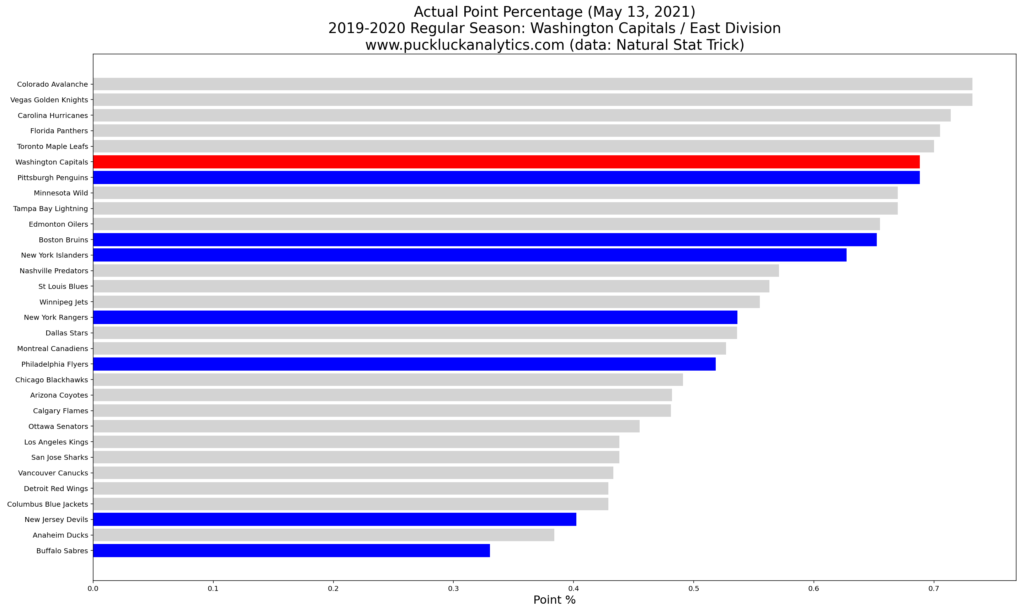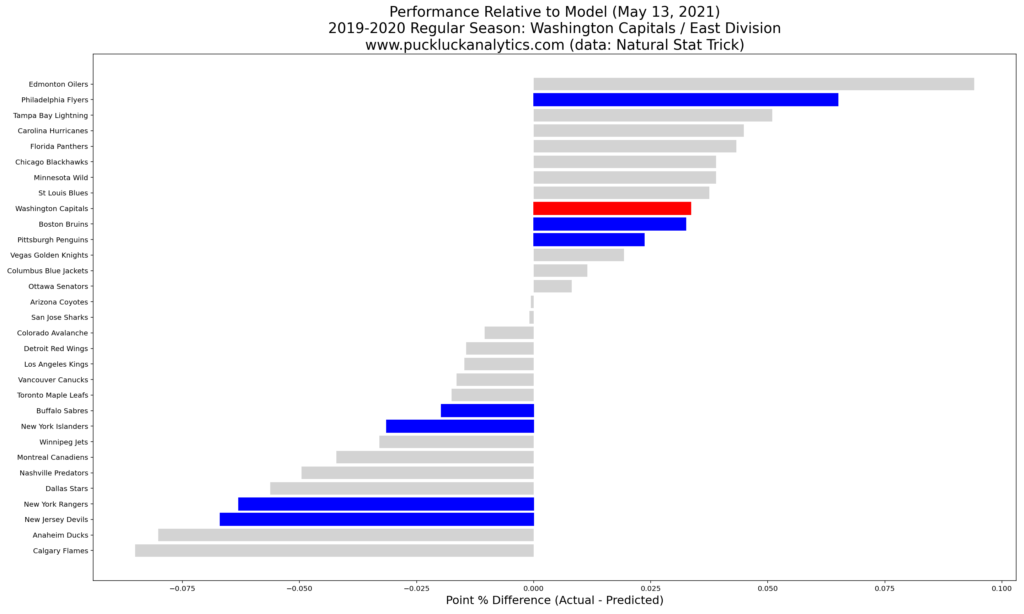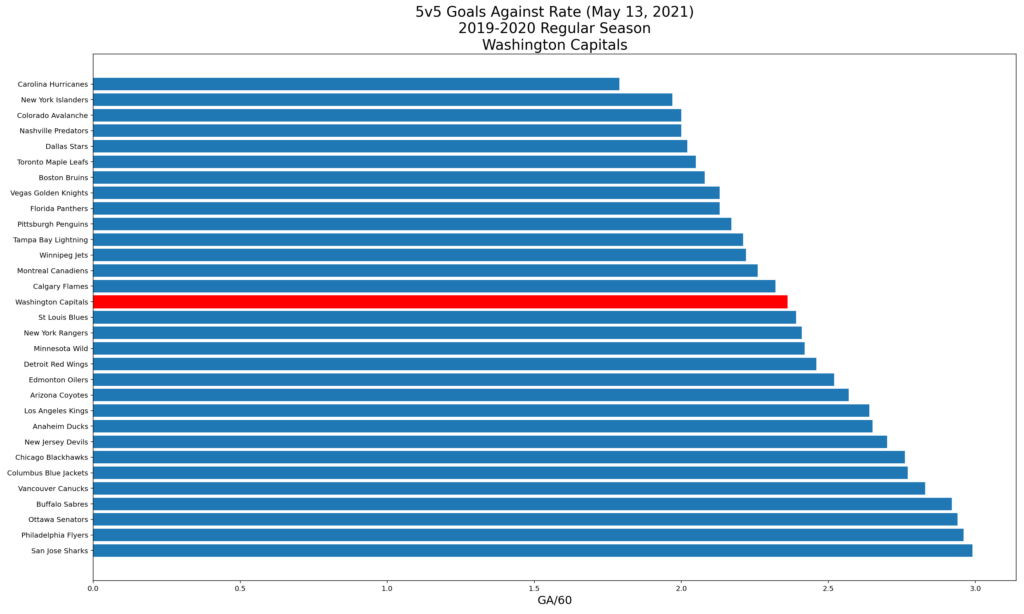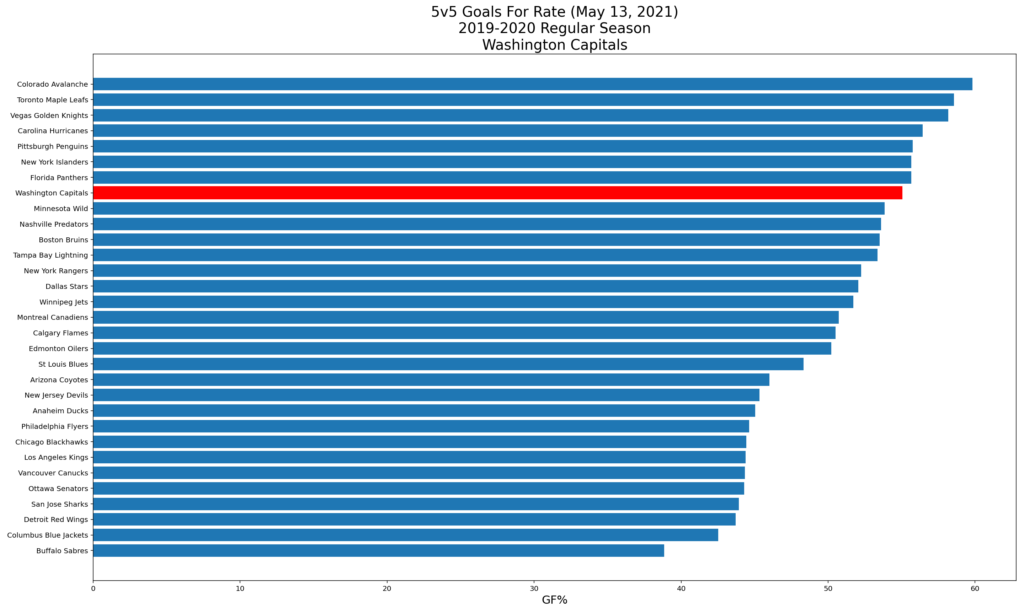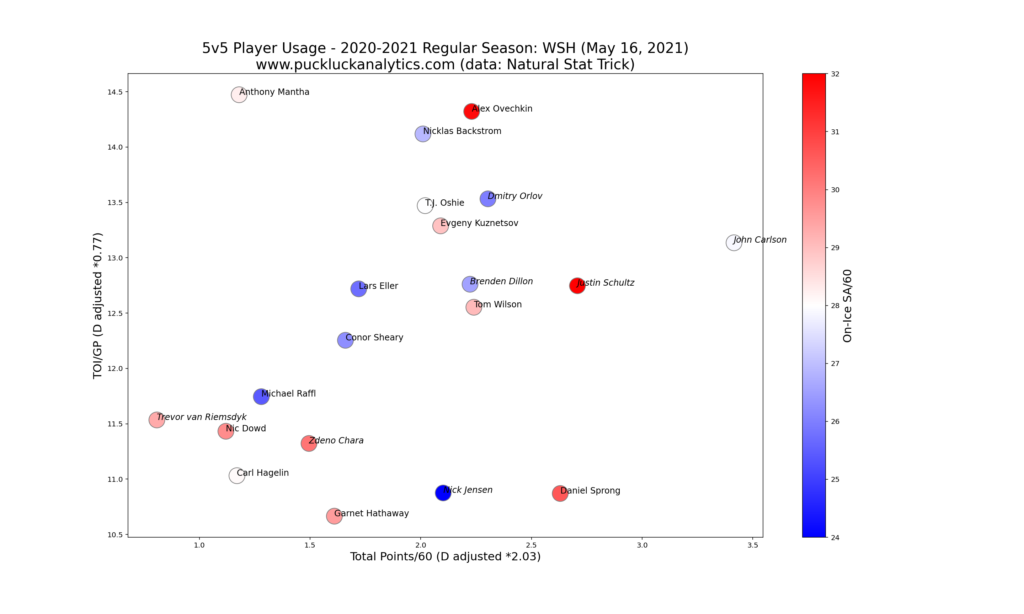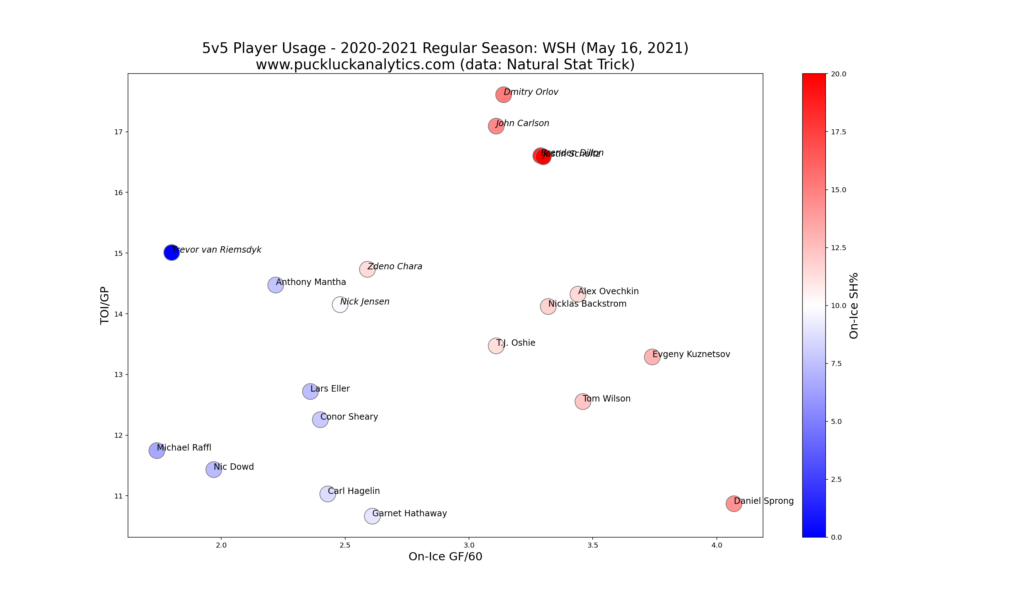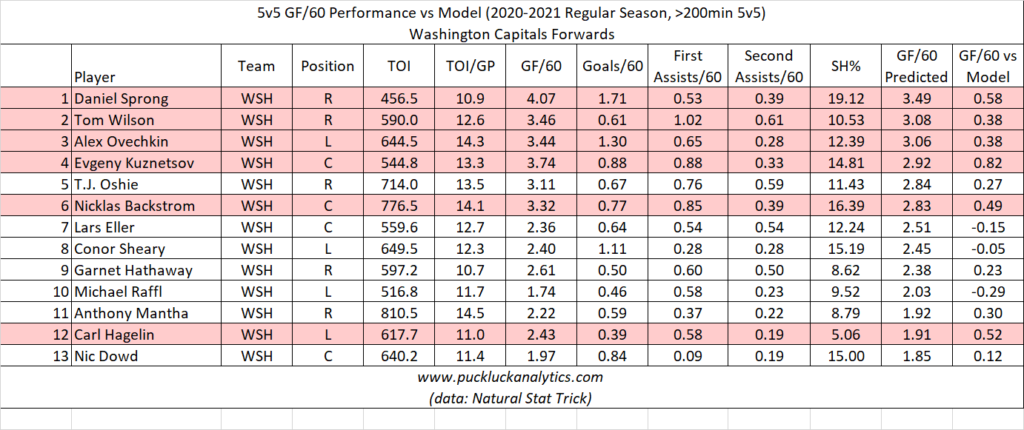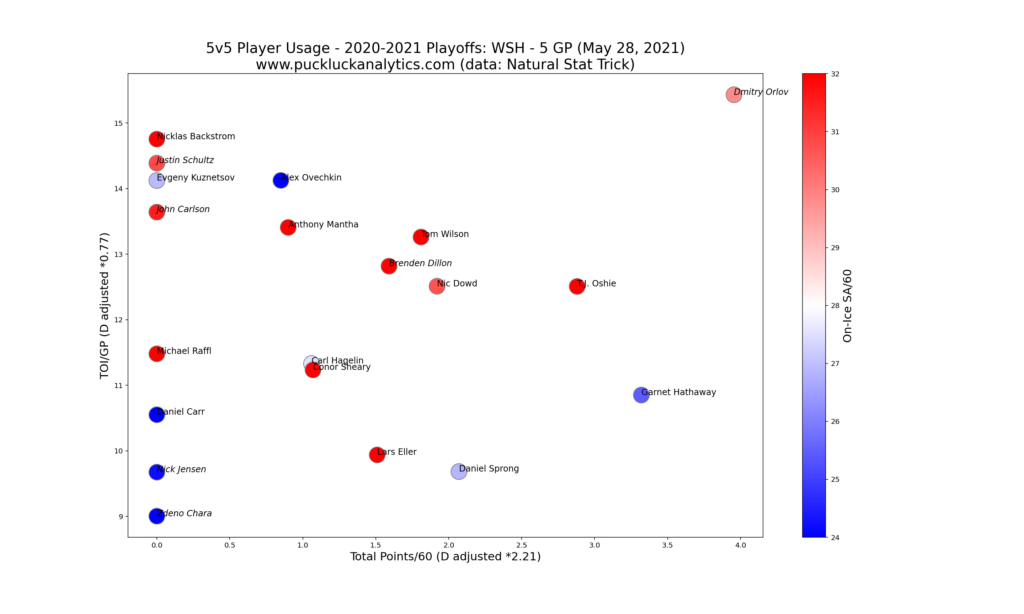The Washington Capitals were one of the established heavyweights in the loaded East Division. Their offense propelled them to the second seed in the division during the regular season and they met the Boston Bruins in the first round, where the Bruins dispatched the Caps in five games. I encourage you to refer to this post for more detail on the plots we’ll look at during the review.
Overall Performance
The Capitals’ offense carried them to a solid regular season that saw them tied with the Penguins for the best point percentage in the division. Let’s take a look at their results along with the results from our points predictor model based on 5v5 goal rates to start dissecting their season.
The Capitals outperformed the model, which shows us their final position in the standings was better than their underlying 5v5 play suggests. However, the difference was not a big one as the model still puts the Caps quite close to the Penguins and Islanders in the East Division.
Let’s take a close look at the 5v5 goal rates feeding the model.
The Capitals offense was third best in the league at 5v5 and their defense was in the middle of the pack. With a modest improvement to their defensive game, the Caps could become a very dangerous team.
Player Performance
We’ll start evaluating player performance with a 5v5 player usage chart. Stats for defensemen have been factored for comparison with forwards in this chart and the result gives us a visual depth chart along the diagonal from top right to bottom left.
One things that stands out on this chart is Alex Ovechkin and Nick Backstrom floating above the diagonal line, which indicates that they may have been over-utilized. With age starting to creep up on these veterans, this is something for us to keep an eye on as we continue. We also see Anthony Mantha well above the diagonal, however we can chalk that up to his numbers in Detroit.
Well below the diagonal, we see Daniel Sprong, Garnett Hathaway, and Nick Jensen. It looks like these players were under-utilized by the Caps this season and we’ll keep an eye out for further signs as we continue.
Next, we’ll look at relative offensive impacts by plotting on-ice GF/60 vs TOI/GP. Players further toward the top right of this plot provided larger contributions to 5v5 team GF/60.
Once again, we see that Sprong’s ice time seems to be out of line with his offensive impact. Otherwise, there aren’t a lot of surprises on this chart.
We get a similar visual of relative defensive impacts using SA/60 vs TOI/GP. This time, players further left and down had better contributions to team GA/60.
Lars Eller, Connor Sheary and Michael Raffl stand out as the players with the strongest defensive impacts. With the league average for players with over 200 minutes at 5v5 being 30 SA/60, the Caps’ players are generally slightly above average. Here we see a reason for Sprong looking under-utilized based on his offensive output, as he has one of the worst defensive impacts on the team. It doesn’t look like a large enough discrepancy from some of the other forwards to fully explain his under-utilization though. Ovechkin also stands out at the far right. While he provides the Caps with plenty of offense, his defensive impact was not stellar this season.
Let’s move on to our on-ice GF/60 models. Comparing the variance between the model outputs and actual on-ice GF/60 gives us an indication of which players carried their line mates offensively. Players with negative variances carried their line mates and we are interested in variances greater than about 0.3.
There are a lot of forwards that over-performed our model significantly. Looking a bit more closely, we also see that many of these players had quite high shooting percentages this season, which inflates the model output. This means the variances may actually be even greater. There isn’t a clear explanation for so many of the Caps players looking like they were carried by their line mates, with no players on the other side of the equation. Perhaps the Capitals had some incredible chemistry, or perhaps this is a red flag that their offensive production is not sustainable.
We see a similar phenomena play out with the Capitals defensemen. Again, there are a number of players outperforming the model significantly, although this time the shooting percentages are closer to average.
The Capitals received relatively average goaltending this season, with the young duo of Vitek Vanacek and Ilya Samsonov carrying the load. Craig Anderson also stepped in with some solid performances in a depth role.
Playoff Performance
While a five game sample certainly isn’t enough for us to make any long term projections, looking at a 5v5 usage chart for the Caps’ short playoff run can give us some insight into what happened against the Bruins.
It’s painfully clear in the chart that the Capitals big guns simply didn’t provide enough offense in the playoffs. The Capitals goaltending was good enough to hold them in the series, with Craig Anderson posting a 0.926 save percentage in two games played and Ilya Samsonov at 0.917 over three games. With depth players like Garnett Hathaway and Lars Eller providing 5v5 offense, the Caps needed more from their top offensive weapons.
Looking Ahead
The Capitals have $72M committed to the 2021-2022 salary cap, leaving them very little room to work with this offseason. With most of the roster under contract for next season, the Caps may have to look to the trade market to improve.
Key RFAs:
The Capitals have no RFAs that finished the season on the NHL roster.
Key UFAs:
Alex Ovechkin is an unrestricted free agent. He has expressed a desire to stay in Washington and, with his goal scoring still among the league leaders, it seems likely the Capitals will try to re-sign the captain.
Zdeno Chara is also without a contract for next season. At age 44, he hasn’t yet confirmed his intentions for next season.
Key Players Under Contract:
The Capitals roster is aging and their contention window with the current core is likely closing. Now in his prime, 26 year old Anthony Mantha could be a player that steps up with increased impact next season.
Tough Questions:
Tight to the cap with an aging roster, can the Capitals re-tool on the fly? They need to get younger to avoid the inevitable decline due to age. Much of their roster is under contract for two or more seasons and the salary cap is expected to be flat for the foreseeable future. Offloading aging players via trade will likely be a difficult task.
Offseason Priority:
The Capitals need to start getting younger. Evgeny Kuznetsov has been rumored to be on the block. With 4 years left at a $7.8M cap hit, moving the 29 year old for younger assets could kill two birds with one stone by also freeing up some cap space.
Check out my other season reviews that have already been posted, such as the New York Rangers and the Los Angeles Kings, and subscribe to catch the rest of my season reviews as they come out.
data: Natural Stat Trick
cap data: CapFriendly

